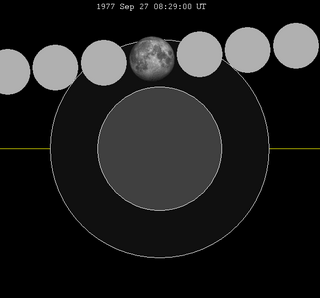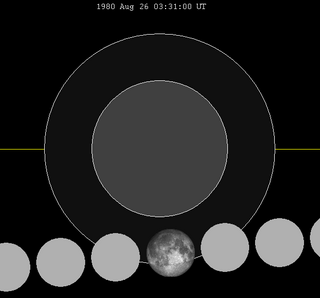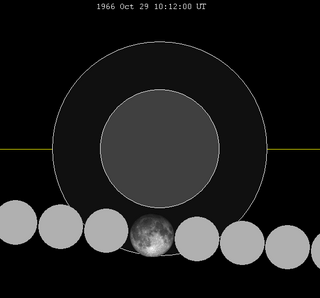
A penumbral lunar eclipse occurred at the Moon’s descending node of orbit on Sunday, September 6, 1998, with an umbral magnitude of −0.1544. A lunar eclipse occurs when the Moon moves into the Earth's shadow, causing the Moon to be darkened. A penumbral lunar eclipse occurs when part or all of the Moon's near side passes into the Earth's penumbra. Unlike a solar eclipse, which can only be viewed from a relatively small area of the world, a lunar eclipse may be viewed from anywhere on the night side of Earth. Occurring about 1.8 days before perigee, the Moon's apparent diameter was larger.

A partial lunar eclipse occurred at the Moon’s descending node of orbit on Saturday, June 25, 1983, with an umbral magnitude of 0.3348. A lunar eclipse occurs when the Moon moves into the Earth's shadow, causing the Moon to be darkened. A partial lunar eclipse occurs when one part of the Moon is in the Earth's umbra, while the other part is in the Earth's penumbra. Unlike a solar eclipse, which can only be viewed from a relatively small area of the world, a lunar eclipse may be viewed from anywhere on the night side of Earth. Occurring about 3.7 days before apogee, the Moon's apparent diameter was smaller.

A penumbral lunar eclipse occurred at the Moon’s ascending node of orbit on Wednesday, October 7, 1987, with an umbral magnitude of −0.0095. A lunar eclipse occurs when the Moon moves into the Earth's shadow, causing the Moon to be darkened. A penumbral lunar eclipse occurs when part or all of the Moon's near side passes into the Earth's penumbra. Unlike a solar eclipse, which can only be viewed from a relatively small area of the world, a lunar eclipse may be viewed from anywhere on the night side of Earth. Occurring about 3.1 days after perigee, the Moon's apparent diameter was larger.

A penumbral lunar eclipse occurred at the Moon’s descending node of orbit on Tuesday, April 14, 1987, with an umbral magnitude of −0.2312. A lunar eclipse occurs when the Moon moves into the Earth's shadow, causing the Moon to be darkened. A penumbral lunar eclipse occurs when part or all of the Moon's near side passes into the Earth's penumbra. Unlike a solar eclipse, which can only be viewed from a relatively small area of the world, a lunar eclipse may be viewed from anywhere on the night side of Earth. Occurring about 4.6 days before perigee, the Moon's apparent diameter was larger.

A total lunar eclipse will occur at the Moon’s ascending node of orbit on Monday, September 8, 2025, with an umbral magnitude of 1.3638. A lunar eclipse occurs when the Moon moves into the Earth's shadow, causing the Moon to be darkened. A total lunar eclipse occurs when the Moon's near side entirely passes into the Earth's umbral shadow. Unlike a solar eclipse, which can only be viewed from a relatively small area of the world, a lunar eclipse may be viewed from anywhere on the night side of Earth. A total lunar eclipse can last up to nearly two hours, while a total solar eclipse lasts only a few minutes at any given place, because the Moon's shadow is smaller. Occurring about 2.6 days after perigee, the Moon's apparent diameter will be larger.

A penumbral lunar eclipse occurred at the Moon’s descending node of orbit on Tuesday, September 27, 1977, with an umbral magnitude of −0.1361. A lunar eclipse occurs when the Moon moves into the Earth's shadow, causing the Moon to be darkened. A penumbral lunar eclipse occurs when part or all of the Moon's near side passes into the Earth's penumbra. Unlike a solar eclipse, which can only be viewed from a relatively small area of the world, a lunar eclipse may be viewed from anywhere on the night side of Earth. Occurring about 6.25 days before apogee, the Moon's apparent diameter was smaller.

A total lunar eclipse occurred at the Moon’s descending node of orbit on Saturday, September 16, 1978, with an umbral magnitude of 1.3268. A lunar eclipse occurs when the Moon moves into the Earth's shadow, causing the Moon to be darkened. A total lunar eclipse occurs when the Moon's near side entirely passes into the Earth's umbral shadow. Unlike a solar eclipse, which can only be viewed from a relatively small area of the world, a lunar eclipse may be viewed from anywhere on the night side of Earth. A total lunar eclipse can last up to nearly two hours, while a total solar eclipse lasts only a few minutes at any given place, because the Moon's shadow is smaller. Occurring about 2.4 days after perigee, the Moon's apparent diameter was larger.

A total lunar eclipse occurred at the Moon’s descending node of orbit on Thursday, September 6, 1979, with an umbral magnitude of 1.0936. A lunar eclipse occurs when the Moon moves into the Earth's shadow, causing the Moon to be darkened. A total lunar eclipse occurs when the Moon's near side entirely passes into the Earth's umbral shadow. Unlike a solar eclipse, which can only be viewed from a relatively small area of the world, a lunar eclipse may be viewed from anywhere on the night side of Earth. A total lunar eclipse can last up to nearly two hours, while a total solar eclipse lasts only a few minutes at any given place, because the Moon's shadow is smaller. Occurring only about 5 hours after perigee, the Moon's apparent diameter was larger.

A penumbral lunar eclipse occurred at the Moon’s descending node of orbit on Tuesday, August 26, 1980, with an umbral magnitude of −0.2531. A lunar eclipse occurs when the Moon moves into the Earth's shadow, causing the Moon to be darkened. A penumbral lunar eclipse occurs when part or all of the Moon's near side passes into the Earth's penumbra. Unlike a solar eclipse, which can only be viewed from a relatively small area of the world, a lunar eclipse may be viewed from anywhere on the night side of Earth. Occurring about 1.7 days before perigee, the Moon's apparent diameter was larger.

A partial lunar eclipse will occur at the Moon’s descending node of orbit on Thursday, September 28, 2034, with an umbral magnitude of 0.0155. A lunar eclipse occurs when the Moon moves into the Earth's shadow, causing the Moon to be darkened. A partial lunar eclipse occurs when one part of the Moon is in the Earth's umbra, while the other part is in the Earth's penumbra. Unlike a solar eclipse, which can only be viewed from a relatively small area of the world, a lunar eclipse may be viewed from anywhere on the night side of Earth. Occurring about 1.9 days before perigee, the Moon's apparent diameter will be larger.

A penumbral lunar eclipse occurred at the Moon’s ascending node of orbit on Friday, June 15, 1973, with an umbral magnitude of −0.6020. A lunar eclipse occurs when the Moon moves into the Earth's shadow, causing the Moon to be darkened. A penumbral lunar eclipse occurs when part or all of the Moon's near side passes into the Earth's penumbra. Unlike a solar eclipse, which can only be viewed from a relatively small area of the world, a lunar eclipse may be viewed from anywhere on the night side of Earth. Occurring only about 3 hours after apogee, the Moon's apparent diameter was smaller.

A penumbral lunar eclipse occurred at the Moon’s descending node of orbit on Saturday, November 6, 1976, with an umbral magnitude of −0.2593. A lunar eclipse occurs when the Moon moves into the Earth's shadow, causing the Moon to be darkened. A penumbral lunar eclipse occurs when part or all of the Moon's near side passes into the Earth's penumbra. Unlike a solar eclipse, which can only be viewed from a relatively small area of the world, a lunar eclipse may be viewed from anywhere on the night side of Earth. Occurring only about 8 hours after apogee, the Moon's apparent diameter was smaller.

A penumbral lunar eclipse occurred at the Moon’s ascending node of orbit on Wednesday, August 27, 1969, with an umbral magnitude of −0.9514. A lunar eclipse occurs when the Moon moves into the Earth's shadow, causing the Moon to be darkened. A penumbral lunar eclipse occurs when part or all of the Moon's near side passes into the Earth's penumbra. Unlike a solar eclipse, which can only be viewed from a relatively small area of the world, a lunar eclipse may be viewed from anywhere on the night side of Earth. Occurring about 2.25 days after perigee, the Moon's apparent diameter was larger.

A penumbral lunar eclipse occurred at the Moon’s descending node of orbit on Thursday, January 18, 1973, with an umbral magnitude of −0.1292. A lunar eclipse occurs when the Moon moves into the Earth's shadow, causing the Moon to be darkened. A penumbral lunar eclipse occurs when part or all of the Moon's near side passes into the Earth's penumbra. Unlike a solar eclipse, which can only be viewed from a relatively small area of the world, a lunar eclipse may be viewed from anywhere on the night side of Earth. Occurring about 2 days after perigee, the Moon's apparent diameter was larger.

A penumbral lunar eclipse occurred at the Moon’s ascending node of orbit on Sunday, July 15, 1973, with an umbral magnitude of −0.9581. A lunar eclipse occurs when the Moon moves into the Earth's shadow, causing the Moon to be darkened. A penumbral lunar eclipse occurs when part or all of the Moon's near side passes into the Earth's penumbra. Unlike a solar eclipse, which can only be viewed from a relatively small area of the world, a lunar eclipse may be viewed from anywhere on the night side of Earth. Occurring about 3 days after apogee, the Moon's apparent diameter was smaller.

A penumbral lunar eclipse occurred at the Moon’s descending node of orbit on Wednesday, April 2, 1969, with an umbral magnitude of −0.3046. A lunar eclipse occurs when the Moon moves into the Earth's shadow, causing the Moon to be darkened. A penumbral lunar eclipse occurs when part or all of the Moon's near side passes into the Earth's penumbra. Unlike a solar eclipse, which can only be viewed from a relatively small area of the world, a lunar eclipse may be viewed from anywhere on the night side of Earth. Occurring about 4.2 days before perigee, the Moon's apparent diameter was larger.

A penumbral lunar eclipse occurred at the Moon’s ascending node of orbit on Saturday, October 29, 1966, with an umbral magnitude of −0.1249. A lunar eclipse occurs when the Moon moves into the Earth's shadow, causing the Moon to be darkened. A penumbral lunar eclipse occurs when part or all of the Moon's near side passes into the Earth's penumbra. Unlike a solar eclipse, which can only be viewed from a relatively small area of the world, a lunar eclipse may be viewed from anywhere on the night side of Earth. Occurring about 4 days after apogee, the Moon's apparent diameter was smaller.

A total lunar eclipse will occur at the Moon’s ascending node of orbit on Saturday, September 19, 2043, with an umbral magnitude of 1.2575. A lunar eclipse occurs when the Moon moves into the Earth's shadow, causing the Moon to be darkened. A total lunar eclipse occurs when the Moon's near side entirely passes into the Earth's umbral shadow. Unlike a solar eclipse, which can only be viewed from a relatively small area of the world, a lunar eclipse may be viewed from anywhere on the night side of Earth. A total lunar eclipse can last up to nearly two hours, while a total solar eclipse lasts only a few minutes at any given place, because the Moon's shadow is smaller. Occurring about 2.8 days before perigee, the Moon's apparent diameter will be larger.

A penumbral lunar eclipse occurred at the Moon’s ascending node of orbit on Saturday, September 15, 1951, with an umbral magnitude of −0.1927. A lunar eclipse occurs when the Moon moves into the Earth's shadow, causing the Moon to be darkened. A penumbral lunar eclipse occurs when part or all of the Moon's near side passes into the Earth's penumbra. Unlike a solar eclipse, which can only be viewed from a relatively small area of the world, a lunar eclipse may be viewed from anywhere on the night side of Earth. Occurring about 3.6 days after perigee, the Moon's apparent diameter was larger.

A penumbral lunar eclipse occurred at the Moon’s ascending node of orbit on Monday, September 4, 1933, with an umbral magnitude of −0.7336. A lunar eclipse occurs when the Moon moves into the Earth's shadow, causing the Moon to be darkened. A penumbral lunar eclipse occurs when part or all of the Moon's near side passes into the Earth's penumbra. Unlike a solar eclipse, which can only be viewed from a relatively small area of the world, a lunar eclipse may be viewed from anywhere on the night side of Earth. Occurring about 3.9 days after perigee, the Moon's apparent diameter was larger.



























































